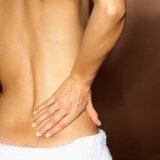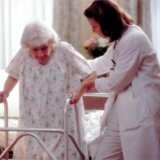Lumbago: what is it, causes, symptoms and treatment
Unfortunately, many today experience back problems due to the various loads on the spine. Sedentary work, lifting weights, hypothermia - all this and much more can cause diseases such as lumbago. If you have never heard this name, this does not mean that you or your loved ones did not have to meet with this ailment in the lumbar region. What is lumbago and how to treat it, you will learn in this article.
Content
- What it is?
- The causes of lumbago
- Provoking factors
- Lumbago symptoms
- Diagnostics
- Treating Acute Lower Back Pain
- Pain relievers
- Massage and manual therapy
- How to help yourself at home
- Prophylaxis
- Finally
What it is?
Lumbago disease - This is a pathology, which is popularly known as "lumbago" in the lower back. It is characterized by acute pain that lasts from a couple of seconds to several minutes or even hours. It always forms in the lumbosacral spine.
By the way, the name of the disease is derived from the Latin "lumbus", which means "loin".
This disease is a manifestation of destructive processes in the spine. The muscles and ligaments of this department also suffer.
Pain in this case is an indicator that there are serious disorders in the lower back. This disease can manifest itself in anyone between the ages of 25-27. Unfortunately, absolutely no one is immune from her, not women, not men.
Lumbago can take on a chronic form, so early detection of this ailment is of great importance. If you have sharp and sharp pain in the lower back, do not postpone the visit to the doctor. Yes, this kind of lumbago happens, from time to time, for almost everyone who is engaged in physical activity. But these sensations can turn into a severe illness very quickly, which means that you need to take lower back pain seriously.
The causes of lumbago

So, you can identify several main causes of this disease:
- osteochondrosis;
- intervertebral hernia;
- overstrain of the muscles of the back and lower back;
- displacement of the intervertebral discs;
- swollen vertebrae.
The main cause of the occurrence is osteochondrosis, its complication in the form of an intervertebral hernia. Congenital anomalies in the development of the spine can also affect. The problem that arises with this disease is the reduction of the gap between the vertebrae. This leads to nerve compression and inflammation. The result is severe pain and muscle spasms.
Provoking factors
The factors that trigger low back pain can be different. But most often, these are:
- exercise stress;
- being in an uncomfortable position for a long time;
- strong tension in the muscles of the back and lower back;
- hypothermia;
- back bruises and other injuries;
- infections;
- colds.
Read also:Lumbosacral sciatica: signs and treatment, medication, alternative therapy
When a hernia appears, the situation becomes even worse: the nerve is compressed by the prolapsed vertebra, which, in turn, causes tension in the muscles of the back. And this leads to a worsening of the situation throughout the body. Due to constant muscle tension, the pressure on the vertebrae does not decrease. This causes pain, and it leads to muscle tension. Thus, a vicious circle is obtained. As a result, painful sensations can last for hours, leading to a complete loss of the patient's normal state.
Also, lumbago can appear when a vertebra is destroyed due to a tumor. It can be tumors located inside the vertebra, or metastases to the vertebrae from other tumors.
Lumbago symptoms
The main symptom is severe back pain. As a rule, it is so intense that the patient loses the ability to move normally and does not allow even the slightest tilt or turn without painful sensations.
Pain can be of the following types:
- shooting;
- sharp;
- pulsating.
The duration of these sensations can vary in duration. The main thing to understand is that if the pain lasts more than two days, you should definitely see a doctor.
Second symptom - This is a very strong tension in the muscles of the lower back and back due to pain. Muscle spasm occurs automatically as the body's response to pain. Sometimes the tension goes into the hips and buttocks.
Third symptom, which is visible to others - this is a violation of mobility. Due to the acute pain sensations, the patient is afraid to make any movements. Typically, a person lies down on a bed or sofa, hoping that the pain will subside. Many lie on a hard surface because they think it might help. Or the person simply freezes in an uncomfortable, usually bent, posture, fearing to make a movement.
If you feel the muscles, you will notice their high tension. The patient can neither straighten himself nor with someone else's help. The transition from one position to another is very difficult.
Diagnostics
Diagnosis of this disease begins with an examination by a doctor. This will help determine the condition of your back and lower back muscles. Of course, the diagnosis can be made during one examination, but it is also necessary to clarify the reasons. lumbago to find the right treatment, and this requires going through various procedures.
The whole process is complicated by the fact that the patient experiences pain and any movement causes discomfort. Therefore, you have to relieve pain and examine a person at the same time.
- The doctor will definitely prescribe general urine analysis and blood to identify the inflammatory processes occurring in the body. This procedure is prescribed for all diseases and this disease is no exception.
- Of course, it will be necessary to conduct X-ray examination (X-ray). This will help identify injury to the vertebrae, if any. Find congenital tumors or defects and abnormalities in the development of the spine. If the patient has osteochondrosis or a simple displacement of the vertebrae, this will also be detected using this procedure.
- Magnetic resonance imaging (MRI) helps to assess the condition of the soft tissues of the spinal cord and intervertebral discs. Which, in turn, will help identify the cause of the disease.
- CT scan will help to identify various injuries of the spine in more detail and more accurately than x-rays. For example, using this procedure, it will be possible to obtain a three-dimensional image of the spine, which will reveal any, even the smallest and, at first glance, minor damage to the discs.
- Spine scintigraphy - this method consists in the introduction of an isotope into the patient's body. It accumulates in the vertebrae, and then pictures are taken, where the places of its accumulation are clearly visible. This allows you to identify cavities with pus, tumor metastases, inflammation of the vertebrae.
Read also:Apraxia
Treating Acute Lower Back Pain
Lumbago treatment can be called complex. There is no one medicine or way to cure an ailment, you need to use several options at the same time for a complete cure. After the doctor determines the cause of the disease, he will be able to prescribe treatment.
It is best to wait for the doctor's recommendations, and not start treatment at home with the help of improvised means, as this can cause even more harm to the back. Especially when it comes to intervertebral hernia or inflammatory processes.
Pain relievers

In the treatment of lumbago, various non-steroidal anti-inflammatory drugs can be used to relieve pain, for example:
- Diclofenac;
- Aspirin;
- Spasmolitin;
- Ibuprofen;
- Nimesulide;
- Celecoxib;
- Rofecoxib.
And other drugs. But before taking it is better to consult a doctor. It is not worth taking medications without the advice of a doctor, even if you know for sure that they can help. Medicines, as well as methods of treatment, are selected only when the cause of the disease becomes known.
Massage and manual therapy
If the cause of lumbago is a dislocated vertebra or other mechanical injury, manual therapy will help. With this technique, the doctor removes the displacement with his hands and sets the vertebra into place. This is a very effective method, the pain may disappear immediately after the procedure, or the recovery will come much faster.
You can also use massage. It should be short and common for the entire back. This procedure is used to improve blood circulation and eliminate muscle pain and inflammation. As a rule, the patient's well-being improves, and recovery occurs faster.
How to help yourself at home

There are special treatment positions in which the patient can take the path of recovery and relieve his suffering. One of these is the following:
- the patient should lie on his back, bending his knees and hip joints;
- a chair or some other object is placed under the feet (see. photo above);
- the height and position of this elevation should be comfortable for the patient so that his legs remain in this position without any discomfort.
Read also:Amyotrophy
If a person is in this position every day for several hours, it will help eliminate pain and recover sooner.
You can also use the following posture to ease the pain. The patient needs to lie on his stomach and put two or three pillows under it. This will help relax the muscles, leading to pain relief.
Prophylaxis
After you have been able to get rid of lumbago, it is worthwhile to do the prevention of the disease. Unfortunately, pain can return even if the treatment is successful and you feel great again. Not immediately, but a crooked spine or weak back muscles can remind of themselves.
First of all, you will have to carefully monitor your posture. Especially if your work involves a long sitting at the computer. You will need to do gymnastics daily to strengthen the muscles of the back and lower back. To do this, watch the following video.
For prevention, it is useful to visit a massage therapist. There are different types of massage for different muscles, a specialist or doctor will help you choose the right ones. Also useful:
- swimming;
- Biking;
- fitness;
- and other activities related to strengthening the muscles of the back.
When preparing for bed, it is better to lie on your side, as this relieves tension from the spine. Of course, at first after healing, and even later, you should not lift weights or in any other way strain your back. If you still have to do this, you need to do it right, keeping your back straight and not bending.
Finally
So, now you know what lumbago is, its symptoms and treatment.
I would like to add that the treatment of lumbago is a very difficult process, therefore it is better to prevent the disease, and not deal with its elimination. To do this, you should keep yourself in good shape through exercise and various procedures. It is also worth remembering that the onset of symptoms can be very sharp and unexpected, but you should not hope that they will also disappear soon.



